Effect of Emulsifier on the Structure and Properties of Waterborne Silicone Antifouling Coating
Abstract
:1. Introduction
2. Materials and Methods
2.1. Materials
2.2. Preparation of Coating
2.3. Characterization
2.3.1. Contact Angle Measurement
2.3.2. Tensile Test
2.3.3. Determination of Crosslinking Density
2.3.4. Infrared Spectrum Analysis
2.3.5. Marine Bacterial Attachment Test
2.3.6. Surface Morphology Observation
2.3.7. Navicula Tenera Adhesion Test
3. Results
3.1. Chemical Structure
3.2. Curing Mechanism
3.3. Crosslinking Density of Coating
3.4. Morphology of Coating
3.5. Surface Properties of Coating
3.6. Tensile Properties of Coating
3.7. Bacterial Adhesion and Desorption Performance of Coating
3.8. Navicula Tenera Adhesion and Desorption Performance of Coating
4. Discussion
5. Conclusions
Author Contributions
Funding
Conflicts of Interest
References
- Clare, A.S. Natural ways to banish barnacles. New Sci. 1995, 145, 38–41. [Google Scholar]
- Yang, W.J.; Neoh, K.G.; Kang, E.T.; Teo, S.L.M.; Rittschof, D. Polymer brush coatings for combating marine biofouling. Prog. Polym. Sci. 2014, 39, 1017–1042. [Google Scholar] [CrossRef]
- Choudhury, R.R.; Gohil, J.M.; Mohanty, S.; Nayak, S.K. Antifouling, fouling release and antimicrobial materials for surface modification of reverse osmosis and nanofiltration membranes. J. Mater. Chem. A 2018, 6, 313–333. [Google Scholar] [CrossRef]
- Fink, J.K. Reactive Polymers: Fundamentals and Applications: A Concise Guide to Industrial Polymers, 3rd ed.; William Andrew: Oxford, UK, 2017. [Google Scholar]
- Ying, P.; Sanping, Z.; Jianlong, Z.; Xiaogang, L.; Yide, X. Controlling factors and progress of low surface energy silicone antifouling coatings. Paint Coat. Ind. 2009, 39, 58–61. [Google Scholar]
- Zhou, J.; Ellis, A.V.; Voelcker, N.H. Recent developments in PDMS surface modification for microfluidic devices. Electrophoresis 2010, 31, 2–16. [Google Scholar] [CrossRef]
- Selim, M.S.; Shenashen, M.A.; El-Safty, S.A.; Higazy, S.A.; Selim, M.M.; Isago, H.; Elmarakbi, A. Recent progress in marine foul-release polymeric nanocomposite coatings. Prog. Mater Sci. 2017, 87, 1–32. [Google Scholar] [CrossRef]
- Zhao, C.C.; Zhang, J.K. Silicone Emulsion and Its Application; Chemical Industry Press: Beijing, China, 2008. [Google Scholar]
- Xu, F.; Wang, T.; Bohling, J.; Maurice, A.M.; Chen, H.; Wu, L.; Zhou, S. Extended hydrophobicity and self-cleaning performance of waterborne PDMS/TiO2, nanocomposite coatings under accelerated laboratory and outdoor exposure testing. J. Coat. Technol. Res. 2018, 15, 1025–1034. [Google Scholar] [CrossRef]
- Sun, Z.; Liu, B.; Huang, S.; Wu, J.; Zhang, Q. Facile fabrication of superhydrophobic coating based on polysiloxane emulsion. Prog. Org. Coat. 2017, 102, 131–137. [Google Scholar] [CrossRef]
- Naghash, H.J.; Mohammadidehcheshmeh, I.; Mehrnia, M. Synthesis and characterization of a novel hydroxy terminated polydimethylsiloxane and its application in the waterborne polysiloxane-urethane dispersion for potential marine coatings. Polym. Adv. Technol. 2013, 24, 307–317. [Google Scholar] [CrossRef]
- Khanjani, J.; Pazokifard, S.; Zohuriaan-Mehr, M.J. Improving dirt pickup resistance in waterborne coatings using latex blends of acrylic/PDMS polymers. Prog. Org. Coat. 2017, 102, 151–166. [Google Scholar] [CrossRef]
- Oliver, J.F.; Mason, S.G. Liquid spreading on rough metal surfaces. J. Mater. Sci. 1980, 15, 431–437. [Google Scholar] [CrossRef]
- ISO 37:2005-Rubber, Vulcanized or Thermoplastic—Determination of Tensile Stress-Strain Properties; International Organization for Standardization: Geneva, Switzerland, 2005.
- Flory, P.J. Principles of Polymer Chemistry; Cornell University Press: Ithaca, NY, USA, 1953. [Google Scholar]
- Zhang, Y.; Qi, Y.; Zhang, Z. Synthesis of PPG–TDI–BDO polyurethane and the influence of hard segment content on its structure and antifouling properties. Prog. Org. Coat. 2016, 97, 115–121. [Google Scholar] [CrossRef]
- Liu, H.; Zhang, Z.P.; Qi, Y.H.; Liu, S.X.; Lin, J.G.; Fang, K.; Zhang, Z.W. Experimental method for evaluation of benthic diatom adhesion on the surface of nontoxic antifouling coatings. Mar. Environ. Sci. 2006, 25, 89–92. [Google Scholar]
- Steward, P.A.; Hearn, J.; Wilkinson, M.C. An overview of polymer latex film formation and properties. Adv. Colloid Interface Sci. 2000, 86, 195–267. [Google Scholar] [CrossRef]
- Wang, B.; Huo, R.T. Study on the hydrolysis process of silane coupling agent. Jinan Text. Chem. Fiber Technol. 2008, 2, 28. [Google Scholar]
- Gong, L.Y.; Liao, G.Z.; Chen, Q.S.; Luan, H.X.; Feng, Y.J. Surfactant swelling micelles: Properties and applications. J. Phys. Chem. 2019, 35, 816–828. [Google Scholar]
- Eduok, U.; Faye, O.; Szpunar, J. Recent developments and applications of protective silicone coatings: A review of PDMS functional materials. Prog. Org. Coat. 2017, 111, 124–163. [Google Scholar] [CrossRef]
- Kanazawa, A.; Ikeda, T.; Endo, T. Novel polycationic biocides synthesis an antibacterial activity of polymeric phosphonium salts. J. Polym. Sci. Part A Polym. Chem. 1993, 31, 335–343. [Google Scholar] [CrossRef]
- Martinez-Tabche, L.; Mora, B.R.; Faz, C.G.; Castelan, I.G.; Ortiz, M.M.; Gonzalez, V.U.; Flores, M.O. Toxic effect of sodium dodecylbenzenesulfonate, lead, petroleum, and their mixtures on the activity of acetylcholinesterase of Moina macrocopa in vitro. Environ. Toxicol. Water Qual. An Int. J. 2015, 12, 211–215. [Google Scholar] [CrossRef]
- Baier, R.E. Surface behavior of biomaterials: The theta surface for biocompatibility. J. Mater. Sci. Mater. Med. 2006, 17, 1057–1062. [Google Scholar] [CrossRef]
- Gui, T.J.; Wang, K. The present situation and development trend of low surface marine antifouling coating. Mod. Coat. Coat. 2010, 13, 32–35. [Google Scholar]


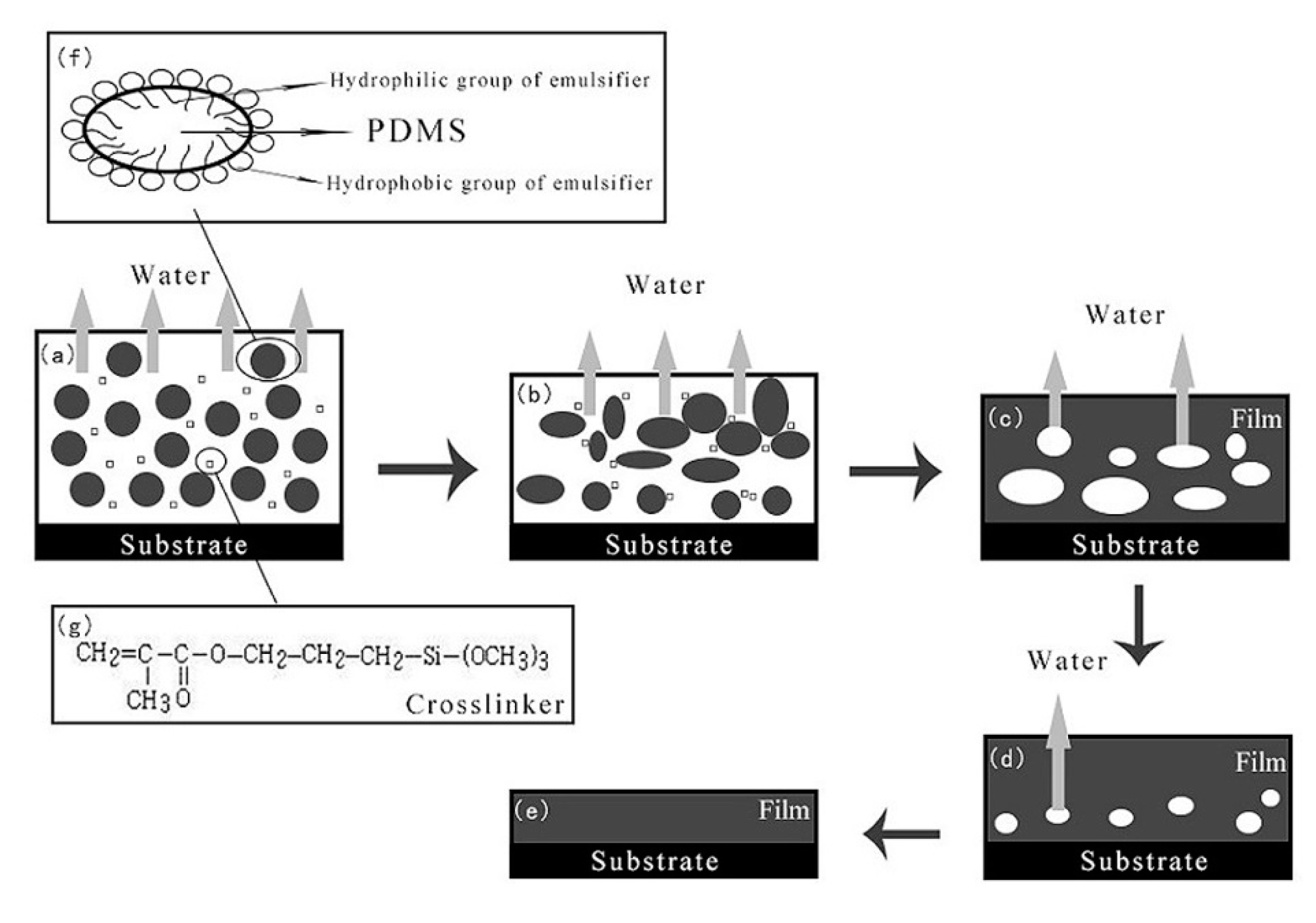
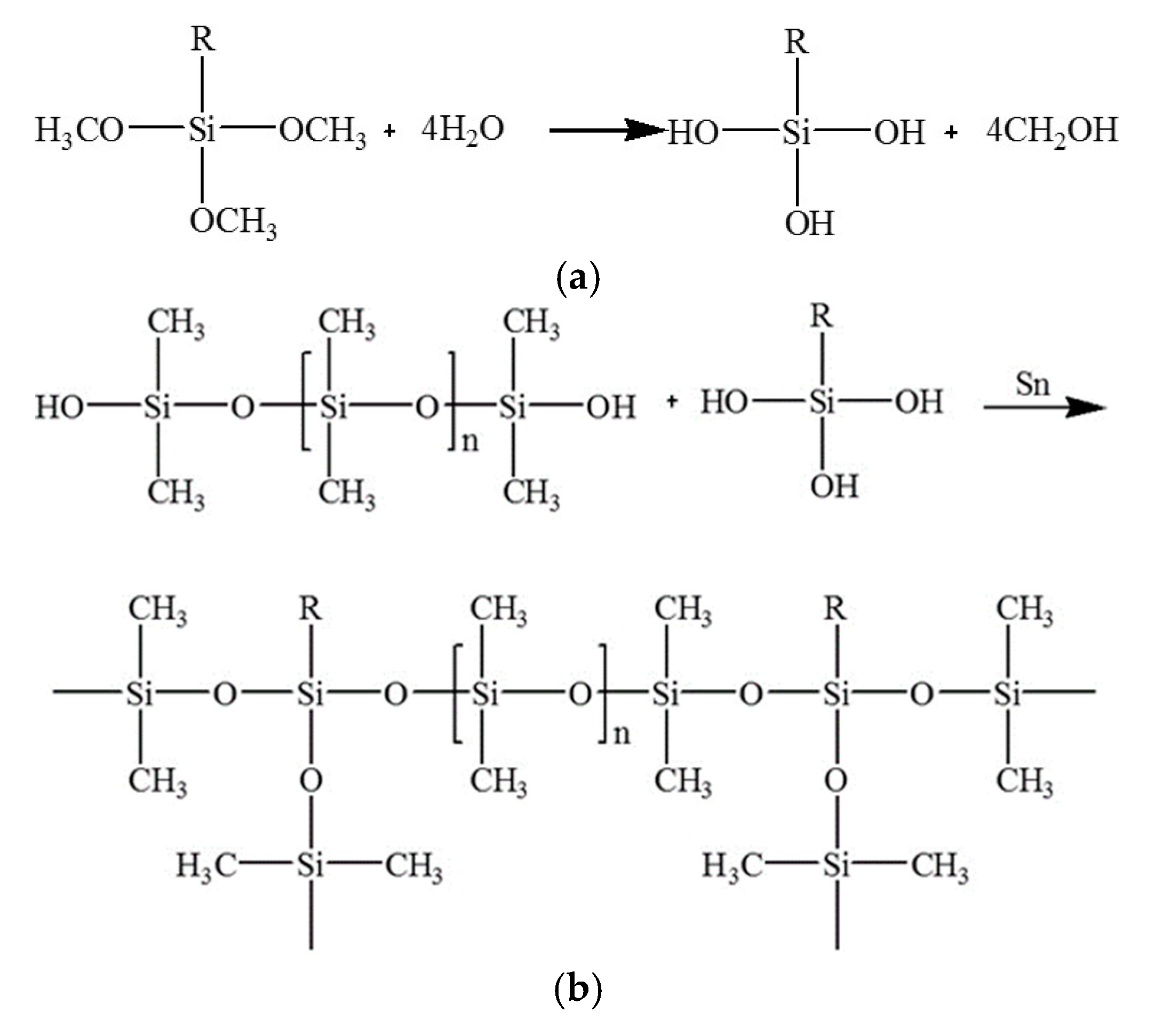

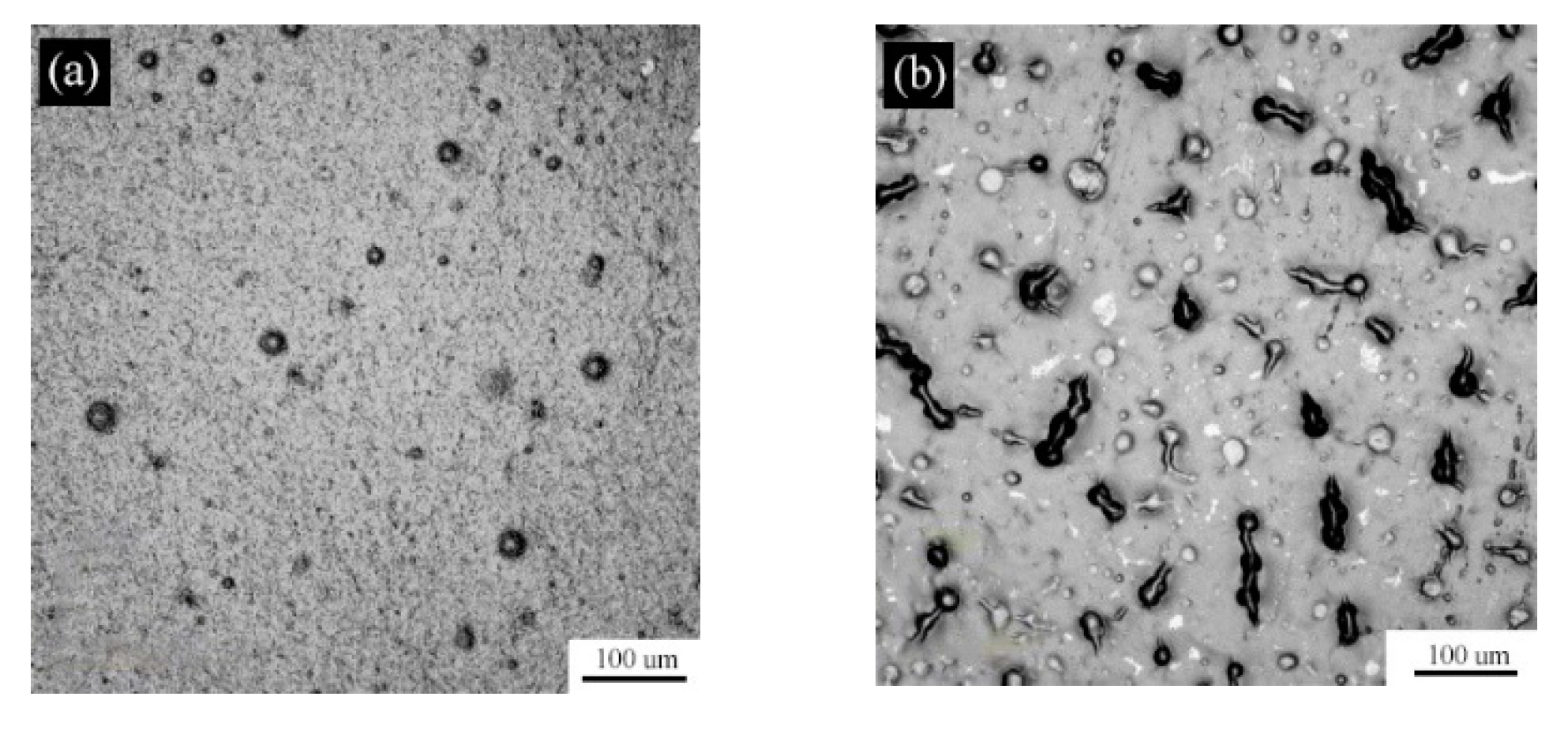
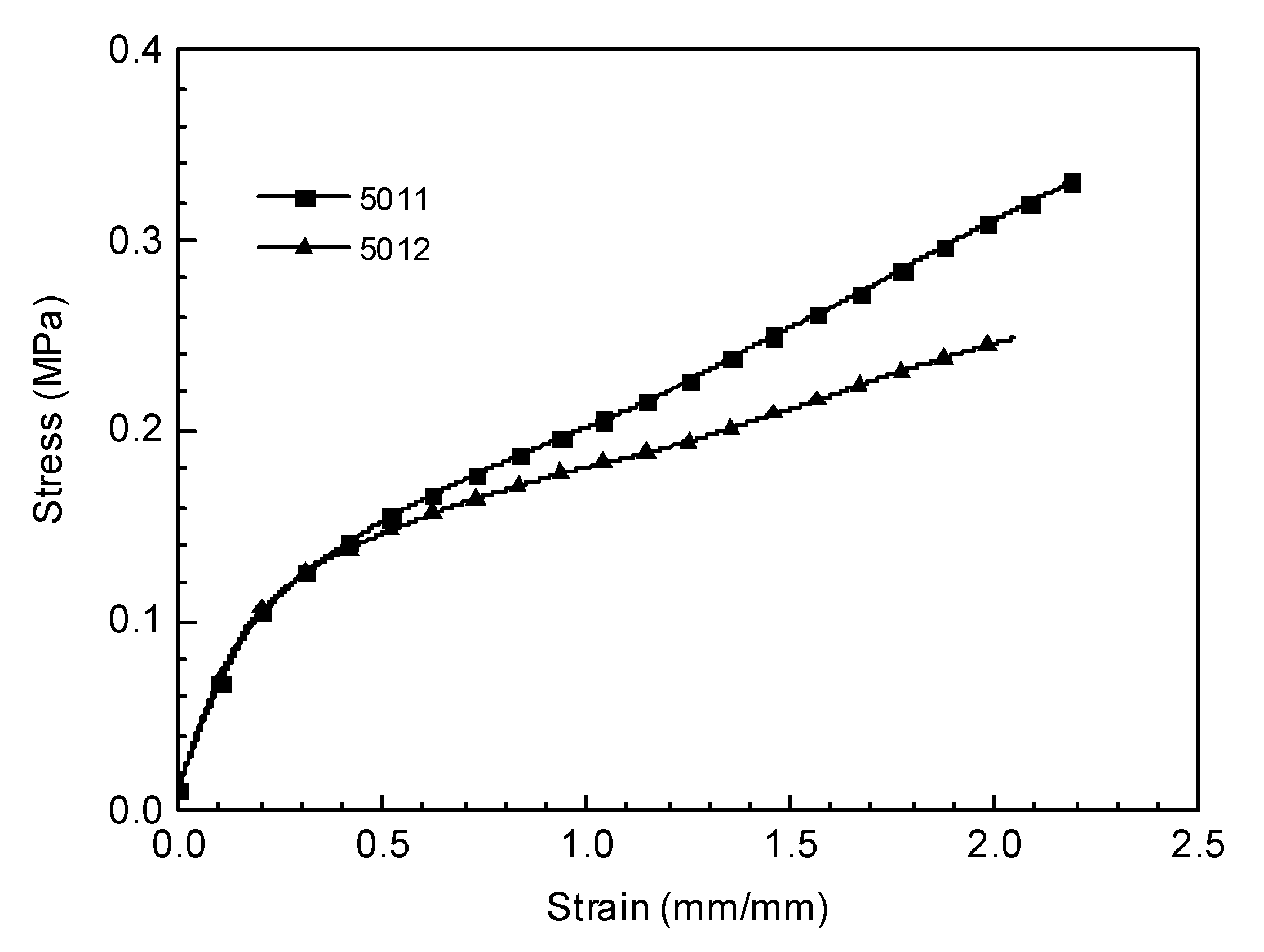
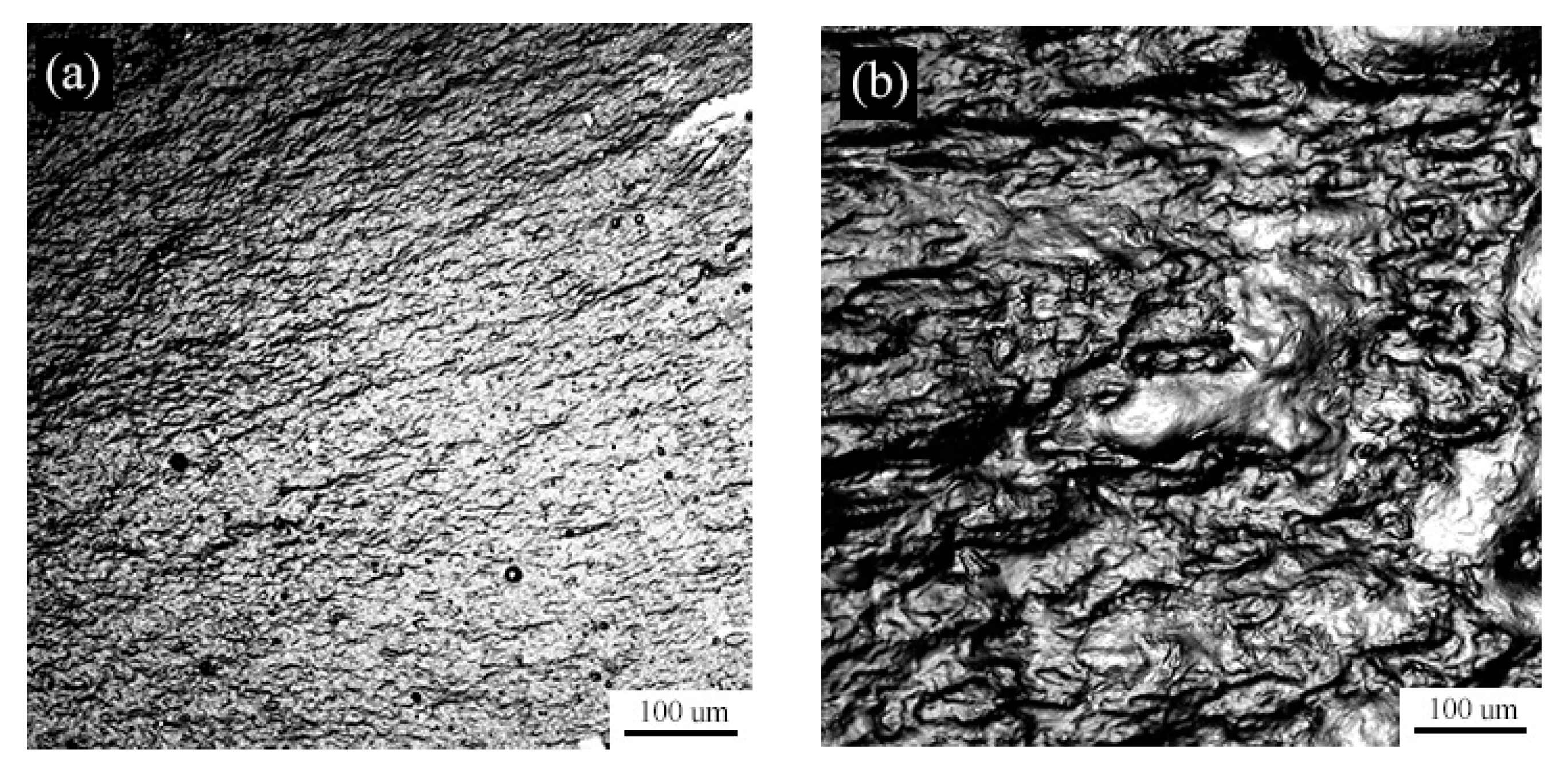
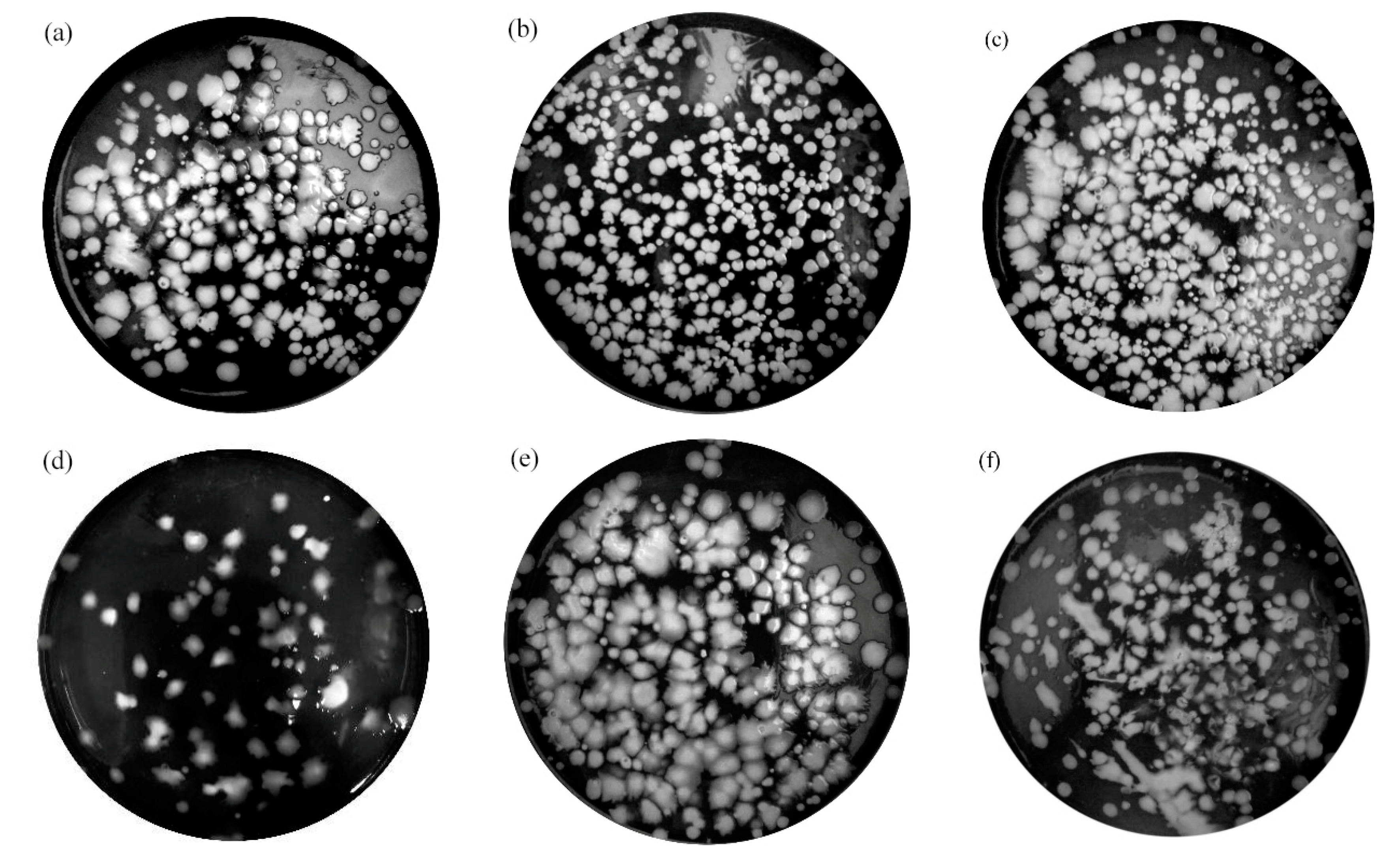

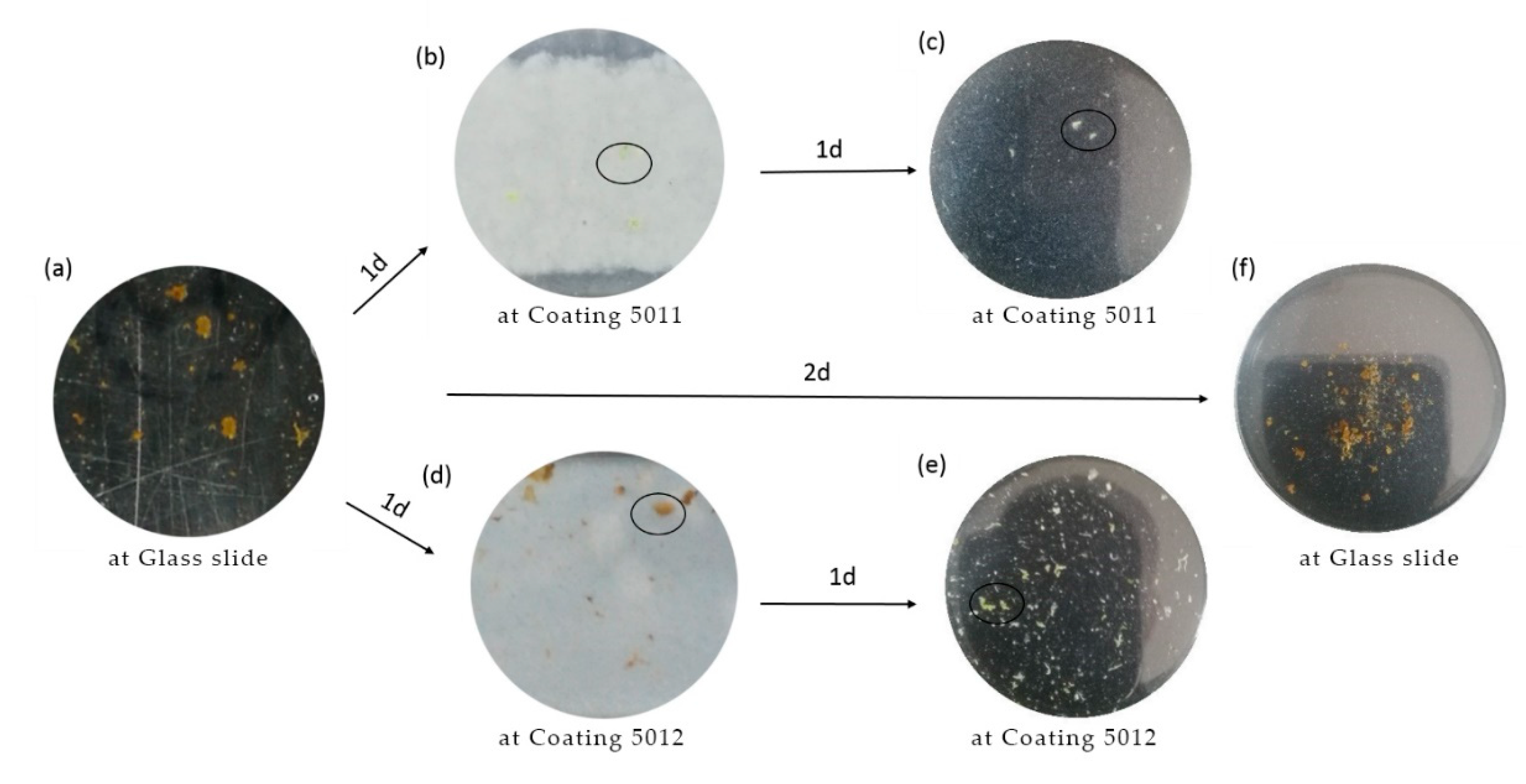
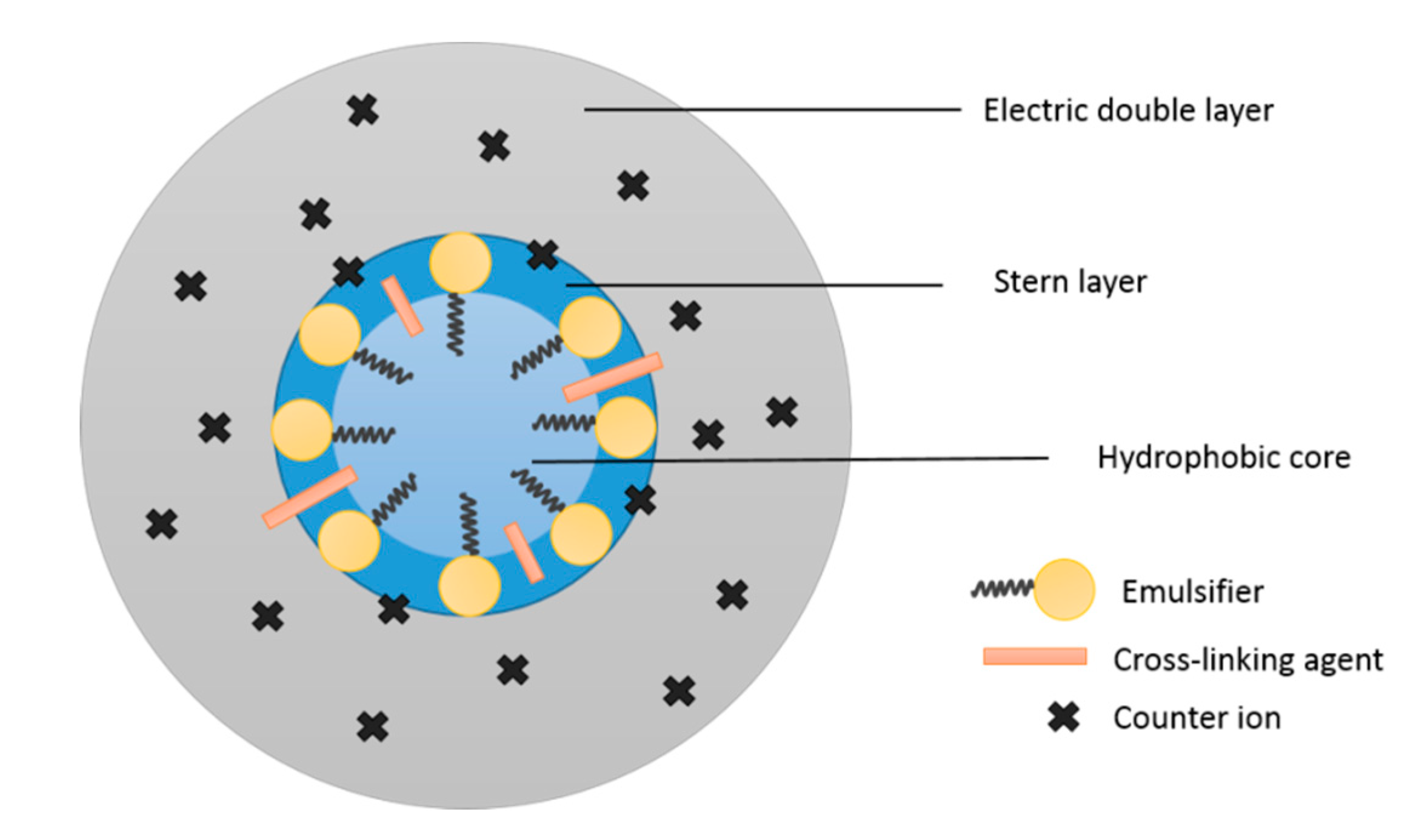
| Ingredients | Peptone | Yeast Extract | FePO4 | Agar | Sterilized Seawater |
|---|---|---|---|---|---|
| Content | 2 g | 0.4 g | 0.004 g | 8 g | 400 mL |
| Sample | Density Before Swelling (g/cm3) | Mc |
|---|---|---|
| 5011 | 0.992 | 6076 ± 128 |
| 5012 | 0.997 | 22189 ± 322 |
| Sample | Contact Angle (°) | Surface Free Energy (mJ/m2) | Surface Roughness Sa (µm) | |
|---|---|---|---|---|
| Water | Diiodomethane | |||
| 5011 | 107.67 ± 1.28 | 85.08 ± 1.85 | 20.01 ± 0.51 | 1.657 |
| 5012 | 109.25 ± 2.07 | 82.67 ± 1.73 | 20.59 ± 0.48 | 6.771 |
| Sample | Elastic Modulus (MPa) | Elongation (%) | Breaking Strength (MPa) |
|---|---|---|---|
| 5011 | 1.12 ± 0.112 | 237 ± 12 | 0.35 ± 0.025 |
| 5012 | 1.11 ± 0.631 | 206 ± 5 | 0.26 ± 0.018 |
| Sample | Chlorophyll Concentration (mg/mL) | Removal Rate (%) | |
|---|---|---|---|
| Washed | Rinsed | ||
| 5011 | 0.09 ± 0.002 | 0.43 ± 0.014 | 78.7 |
| 5012 | 1.41 ± 0.187 | 3.80 ± 0.098 | 62.8 |
| Glass slide | 27.60 ± 1.34 | 44.90 ± 2.85 | 38.5 |
| Sample | Relative Adhesion Factor | Number of Attached Colonies (×106 CFU) |
|---|---|---|
| 5011 | 4.73 ± 0.238 | 190 ± 23 |
| 5012 | 4.78 ± 0.550 | 242 ± 42 |
| Sample | Relative Adhesion Factor | Elastic Modulus (MPa) | Fouling Removal Rate (%) | Roughness (µm) |
|---|---|---|---|---|
| 5011 | 4.73 ± 0.238 | 1.12 ± 0.112 | 57.4 ± 4.95 | 1.657 |
| 5012 | 4.78 ± 0.550 | 1.11 ± 0.631 | 32.6 ± 3.87 | 6.771 |
© 2020 by the authors. Licensee MDPI, Basel, Switzerland. This article is an open access article distributed under the terms and conditions of the Creative Commons Attribution (CC BY) license (http://creativecommons.org/licenses/by/4.0/).
Share and Cite
Liu, S.; Zhang, Z.; Qi, Y. Effect of Emulsifier on the Structure and Properties of Waterborne Silicone Antifouling Coating. Coatings 2020, 10, 168. https://doi.org/10.3390/coatings10020168
Liu S, Zhang Z, Qi Y. Effect of Emulsifier on the Structure and Properties of Waterborne Silicone Antifouling Coating. Coatings. 2020; 10(2):168. https://doi.org/10.3390/coatings10020168
Chicago/Turabian StyleLiu, Sikui, Zhanping Zhang, and Yuhong Qi. 2020. "Effect of Emulsifier on the Structure and Properties of Waterborne Silicone Antifouling Coating" Coatings 10, no. 2: 168. https://doi.org/10.3390/coatings10020168
APA StyleLiu, S., Zhang, Z., & Qi, Y. (2020). Effect of Emulsifier on the Structure and Properties of Waterborne Silicone Antifouling Coating. Coatings, 10(2), 168. https://doi.org/10.3390/coatings10020168




